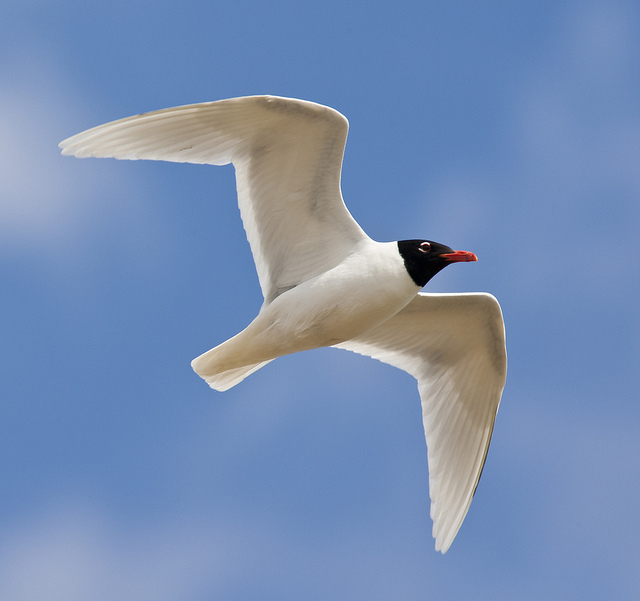 Some Mediterranean Gulls overwinter round the Lizard coast, before returning to their summer breeding grounds.
Some Mediterranean Gulls overwinter round the Lizard coast, before returning to their summer breeding grounds.
Photo: © Allan Drewitt/Natural England
Scientific name: Larus melanocephalus
Conservation status: UK Birds of Conservation Concern, Amber; IUCN Red List, Least Concern.
What to look for:
- Colouring and appearance: In breeding plumage (see photo), the head is completely black; grey wings with all-white wingtips, white breast and lower parts, red beak and legs. The beak has a black band. In winter, the gull has a black smudgy mark behind each eye (see lower photo).
- Size: Length 37 cm, wingspan 96 cm.
- Where: Round the coast in winter; small breeding colonies in the south-east in summer.
- Call: A nasal call
- Similar species: Black-headed Gull, which is slightly smaller and in breeding plumage only has a black face, does not have all-white wingtips, and in winter has a neat black spot rather than dusky smudge behind the eye.
 If you went back in time to the first half of the twentieth century, a sighting of a Mediterranean Gull would create much excitement in the birding community. This was a very rare bird in the UK until comparatively recently, but it has been spreading north-west across Europe from the Mediterranean area that gives it its name, and is now reaching our shores in ever increasing numbers. Some 600 pairs now breed in the south and east of the UK, and 1,800 birds overwinter round the coast or inland at reservoirs and lakes.
If you went back in time to the first half of the twentieth century, a sighting of a Mediterranean Gull would create much excitement in the birding community. This was a very rare bird in the UK until comparatively recently, but it has been spreading north-west across Europe from the Mediterranean area that gives it its name, and is now reaching our shores in ever increasing numbers. Some 600 pairs now breed in the south and east of the UK, and 1,800 birds overwinter round the coast or inland at reservoirs and lakes.
Mediterranean Gulls nest in colonies in marshy areas or among reeds, and will sometimes share breeding grounds with Black-headed Gulls. The female lays up to three eggs, and the young are cared for by both parents after hatching. The birds eat a varied diet, including carrion, fish and insects.
Did you know…?
…The maximum age recorded for a Mediterranean Gull is over 15 years old.
…Back in the 1960s there were fears that Mediterranean Gulls were at risk of extinction given their restricted distribution. Their current expansion means numbers have increased dramatically.
More information and references:
Svensson, L., Mullarney, K., Zetterstrom, D.,1986. Collins Bird Guide, second edition (translated by Christie, D., Svensson, L.). HarperCollins, London.
Published: February 2015
Author: Amanda Scott
Photos: ©Natural England/Allan Drewitt
